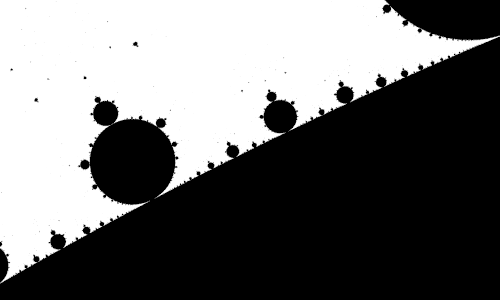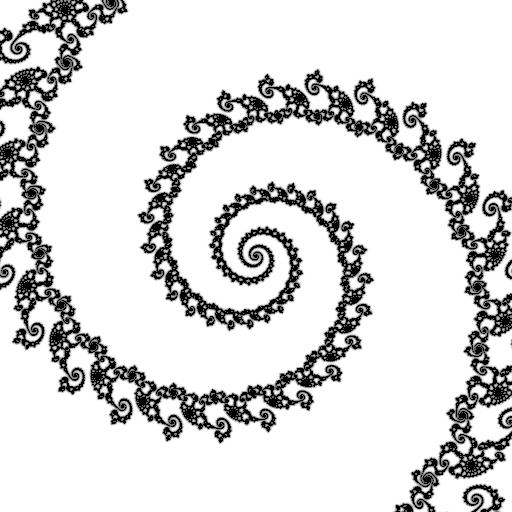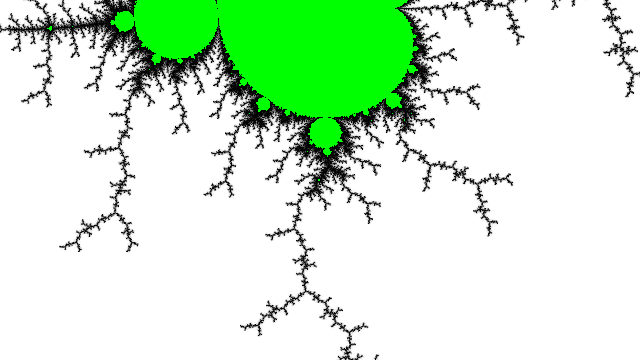I'm wondering what complex number or numbers is preferable to have at the center of a view of a Mandelbrot Set as the viewing range becomes increasingly smaller in order that the complexity of the set becomes visible. On any point in the set, the view will eventually become a solid region of points that are all within the set(infinite iterations), while for many points that aren't in the set, a similar thing will occur for a region of points not in the set. I'm wondering if there is a way to determine what the center of the view of the Mandelbrot Set will give a meaningful view for arbitrary viewing ranges.
-
$\begingroup$ You are asking if there are points where any neighborhood of that point contains points which are in the Mandelbrot set and points that are not? My guess is that there are infinitely many. I believe one would be at -2, though I'm not sure it would make such an interesting zoom. $\endgroup$– Josh B.Mar 10, 2017 at 23:33
-
$\begingroup$ Different points of the Mandelbrot set have different small scale behaviors. No single close-up of one point will give a meaningful view of the whole Mandelbrot set. In fact, the more you zoom in to a single point, the more special the view will be, losing more and more information about the global structure of the Mandelbrot set. $\endgroup$– Lee MosherMar 14, 2017 at 18:25
-
$\begingroup$ Also, since the Mandelbrot set is closed, its complement is open. Each point of the complement is therefore the center of an open ball disjoint from the Mandelbrot set, and so zooming sufficiently closely into each such point you see only a vacuum entirely disjoint from the Mandelbrot set. $\endgroup$– Lee MosherMar 14, 2017 at 18:27
-
2$\begingroup$ One last thing, for each point $p$ in the topological frontier of the Mandelbrot set, every open ball around $p$ contains points both of the Mandelbrot set and of its complement, and therefore no matter how much you zoom into $p$ you will never see a solid region of points that are all within the set. $\endgroup$– Lee MosherMar 14, 2017 at 18:30
3 Answers
You want a point on the boundary of the Mandelbrot set. Even so, "simple" ways to choose boundary points are not so interesting, because they eventually loop.
Points at rational internal angles (measured in turns) of hyperbolic components are at cusps, so zooming in will give one or two straight lines from the center, and only then if interior colouring is used.
Points at some irrational internal angles (measured in turns) of hyperbolic components exhibit (approximate) self-similarity, with the periods of the disc-like components increasing according to the Fibonacci sequence:
There is also approximate self-similarity about Feigenbaum points at the tip of period-doubling cascades:
The Mandelbrot set is asymptotically self-similar around Misiurewicz points (pre-periodic points in the boundary of the Mandelbrot set filaments, typically spiral centers and tips of filaments):
Iterative renormalization: a "minibrot" in the filaments of a parent minibrot, repeatedly zooming to the same location relative to the next child minibrot, pruning off the additional decorations by choice of colouring algorithm. This is a generalization of Feigenbaum points.
Ultimately, "interesting" zoom paths require aesthetic choices of where to zoom.
Misiurewicz points, which lie on the boundary of the Mandelbrot set, provide an interesting location to zoom in. There are some illustrations near the end of the Wikipedia article. By definition, Misiurewicz points $M_{k,n}$ are the roots of equation $f_c^{(k)}(0) = f_c^{(k+n)}(0)$ where $f(z) = z^2+c$ and superscipts mean iteration. Two simple examples are $-2$ (which is $M_{2,1}$) and $i$ (which is $M_{2,2}$), but the more interesting points (with larger $k$ or $n$) lead to algebraic equations for $c$ that cannot be solved exactly.
There are some interesting point to search for in a Mandelbrot zoom. One of them is -e/7-e/20i, which is basically the coordinates of the famous Seahorse valley which is at the 'neck' of the beetle. Wolfram Maths shows -0.75 + 0.1i, but the problem is that after a while you get to a blank spot, whereas since e is a number with infinite complexity, you can always zoom in more and see more interesting stuff. I mean, this isn't a sophisticated explanation cos I thought of this after finding that those numbers get to Seahorse valley to quite a high zoom value.
Edit: I don't know if these are Misiurewicz points, nor do I know how to check




